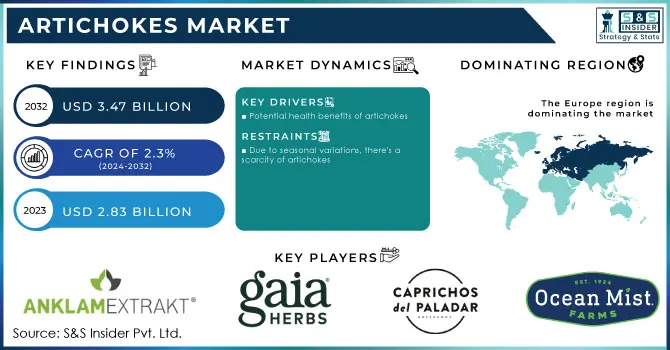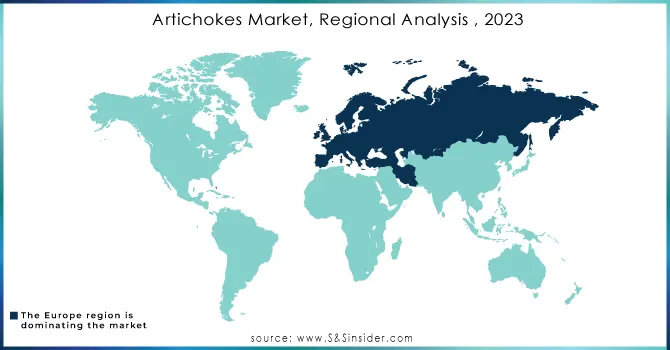Artichokes Market Report Scope & Overview:

Get More Information on Artichokes Market - Request Sample Report
The Artichokes Market size was USD 2.83 billion in 2023 and is expected to Reach USD 3.47 billion by 2032 and grow at a CAGR of 2.3% over the forecast period of 2024-2032.
Artichokes are high in fiber, vitamins, and minerals, and they have been linked to a variety of health advantages. Anti-inflammatory substances found in artichokes may aid to lessen inflammation in the body. People who suffer from rheumatoid arthritis or other chronic inflammatory diseases may find this helpful.
Fresh artichokes have a significant share in the market due to their functional properties. The product's natural appearance and consumer awareness of healthy, minimally processed food make it appealing to customers, adding to the segment's growth.
The frozen segment and canned segment are likely to witness fast growth owing to their availability throughout the year. They are typically blanched before freezing, which helps to preserve their flavor and texture. Frozen artichokes are often used in cooked dishes, such as stews and pasta dishes.
Canned artichokes are the most convenient form of artichokes and are available year-round. They are typically packed in water or brine, and they may contain added salt or preservatives. Canned artichokes are often used in salads and dips.
MARKET DYNAMICS
KEY DRIVERS
-
Potential health benefits of artichokes
Artichokes are high in antioxidants and bioactive compounds such as apigenin and luteolin. Several studies have detected silymarin, a flavonoid that acts as an anticancer agent, is present in artichoke extracts which has a negative impact on breast cancer cells. Artichokes' polyphenols and antioxidants, including quercetin, rutin, and gallic acid, have also been found to suppress the growth of malignant cells. Artichokes help to promote liver function and cleansing.
RESTRAIN
-
Due to seasonal variations, there's a scarcity of artichokes
Artichokes is a flower obtained seasonally, generally, they have two seasons, fall and spring. The product's seasonality has an impact on its prices because off-season prices are high, which is anticipated to impede expansion. Also, Artichokes are prone to a variety of pests and diseases, which can result in crop losses.
OPPORTUNITY
-
Development of new varieties of artichokes
-
Awareness of Jerusalem artichokes' functional properties
Jerusalem artichokes are high in inulin, a form of soluble fiber with numerous health advantages, including improving gut health by feeding beneficial bacteria in the gut, controlling blood sugar levels, lowering cholesterol levels, promoting weight loss, and protecting against cancer. There are numerous applications for Jerusalem artichoke as an active ingredient, including not just prebiotic foods but also products with a low glycemic index and high antioxidant characteristics.
CHALLENGES
-
High cost of Artichokes
-
Competition from other vegetables
Artichokes fight for market share with other vegetables such as broccoli and asparagus. These crops are frequently less expensive and simpler to find, making it harder for artichokes to compete.
IMPACT OF RUSSIA-UKRAINE WAR
Russia and Ukraine are major producers of artichokes. Russia was the world's leading producer of artichokes in 2021, followed by Ukraine. The war has hindered the production and export of artichokes from these countries, resulting in a global shortage of artichokes. The artichoke export market has fallen by 25%. The war has also influenced artichoke demand. The war has produced economic instability and inflation, resulting in a drop in consumer expenditure. This has reduced demand for artichokes, particularly in Europe, which is a significant market for the vegetable.
IMPACT OF ONGOING RECESSION
The recession has increased artichoke prices, resulting in a decline in exports, yet market demand is static due to its functional features. Artichokes have increased in price by 20% since the start of the war. During a recession, consumers may reduce their discretionary expenditure, and artichokes are frequently regarded as a luxury item. This could result in less demand for artichokes, resulting in lower pricing and job losses in the industry. Also, the consumption of artichokes declined in the United States and Europe in a particular period.
MARKET SEGMENTATION
by Form
-
Fresh
-
Frozen
-
Canned
by End-User
-
Food & Beverage
-
Personal Care & Cosmetic
-
Pharmaceutical
REGIONAL ANALYSIS
European region dominates the artichokes market as countries like France, Italy, Belgium, Germany, and Switzerland are major importers of artichokes. The increase in consumption of organic fruit in Europe has driven the market growth. According to the American Society for Horticultural Science Italy ranks first in terms of artichoke surface area (35.593 hectares), followed by Egypt (17.895 ha) and Spain (16,000 ha). Furthermore, manufacturers are spending on R&D initiatives to investigate what is driving market growth.
South America is expected to develop due to increased production in Argentina and Peru, as well as the widespread use of Cynara in a variety of food products. Because of their pungent green flavor, Peruvian artichokes are preferred. It's a healthful addition to appetizers. The Association of Exporters from Peru (ADEX) will increase production capacity, which will raise market value even more.
North America, particularly the United States, is likely to see significant growth as people become more aware of the product's health benefits. To meet the increased demand, major businesses are producing products with the nutritious content of artichokes. The rising Hispanic population and the rising popularity of Mediterranean cuisine are the main factors driving the demand for artichokes.

Need Any Customization Research On Artichokes Market - Inquiry Now
REGIONAL COVERAGE
North America
-
US
-
Canada
-
Mexico
Europe
-
Eastern Europe
-
Poland
-
Romania
-
Hungary
-
Turkey
-
Rest of Eastern Europe
-
-
Western Europe
-
Germany
-
France
-
UK
-
Italy
-
Spain
-
Netherlands
-
Switzerland
-
Austria
-
Rest of Western Europe
-
Asia Pacific
-
China
-
India
-
Japan
-
South Korea
-
Vietnam
-
Singapore
-
Australia
-
Rest of Asia Pacific
Middle East & Africa
-
Middle East
-
UAE
-
Egypt
-
Saudi Arabia
-
Qatar
-
Rest of Middle East
-
-
Africa
-
Nigeria
-
South Africa
-
Rest of Africa
-
Latin America
-
Brazil
-
Argentina
-
Colombia
-
Rest of Latin America
KEY PLAYERS
Ocean Mist Farms, Caprichos del Paladar S.L.U., Gaia Herbs Inc., King Herbs Ltd., Anklam Extrakt GmbH, Agro T18 Italia Srl, Master Fruit Srl, The Sa Marigosa Op, Herrawi Group, Ole!, and other key players are mentioned in the final report.
RECENT DEVELOPMENTS
In 2023, Ocean Mist Farms, a top producer and distributor of fresh artichokes in North America, started its yearly spring campaign to highlight the advantages of its renowned Gold Standard of artichokes in terms of health and nutrition.
In 2023, Ocean Mist Farms launched the "Eat Your Heart Out" Consumer Artichoke Sweepstakes promotion. To increase demand and in-store sales, this comprehensive campaign includes marketing to a large network of artichoke merchants and vegetable purchasers, social media promotion, and sweepstakes prizes.
| Report Attributes | Details |
| Market Size in 2023 | USD 2.83 Billion |
| Market Size by 2032 | USD 3.47 Billion |
| CAGR |
CAGR of 2.3% From 2024 to 2032 |
| Base Year | 2023 |
| Forecast Period | 2024-2032 |
| Historical Data | 2020-2022 |
| Report Scope & Coverage | Market Size, Segments Analysis, Competitive Landscape, Regional Analysis, DROC & SWOT Analysis, Forecast Outlook |
| Key Segments | • By Form (Fresh, Frozen and Canned) • By End-User (Food & Beverage, Personal care & Cosmetic, Pharmaceutical) |
| Regional Analysis/Coverage | North America (US, Canada, Mexico), Europe (Eastern Europe [Poland, Romania, Hungary, Turkey, Rest of Eastern Europe] Western Europe] Germany, France, UK, Italy, Spain, Netherlands, Switzerland, Austria, Rest of Western Europe]), Asia Pacific (China, India, Japan, South Korea, Vietnam, Singapore, Australia, Rest of Asia Pacific), Middle East & Africa (Middle East [UAE, Egypt, Saudi Arabia, Qatar, Rest of Middle East], Africa [Nigeria, South Africa, Rest of Africa], Latin America (Brazil, Argentina, Colombia Rest of Latin America) |
| Company Profiles | Ocean Mist Farms, Caprichos del Paladar S.L.U., Gaia Herbs Inc., King Herbs Ltd., Anklam Extrakt GmbH, Agro T18 Italia Srl, Master Fruit Srl, The Sa Marigosa Op, Herrawi Group, Ole! |
| Key Drivers | • Potential health benefits of artichokes |
| Market Challenges | • High cost of Artichokes • Competition from other vegetables |

